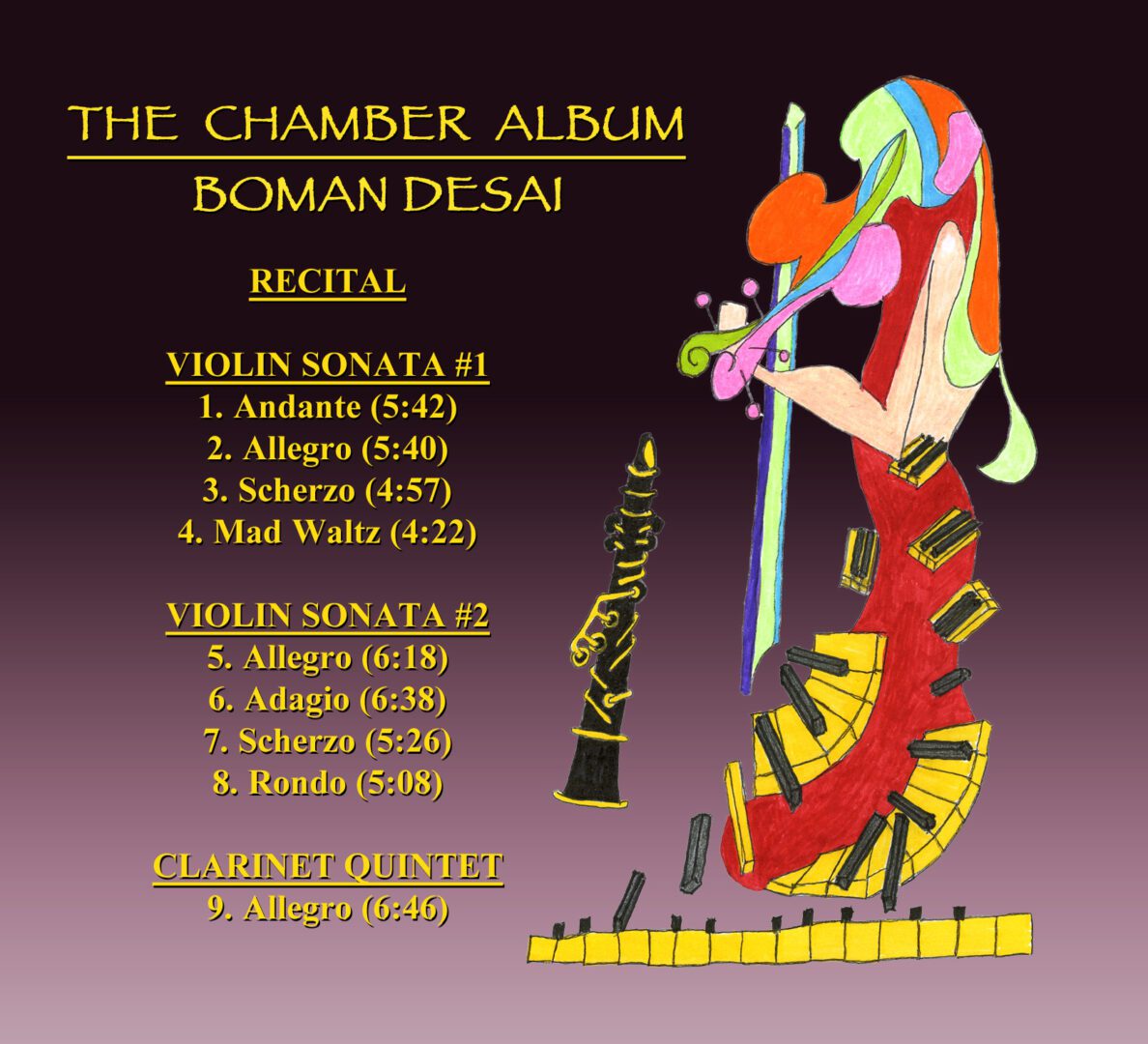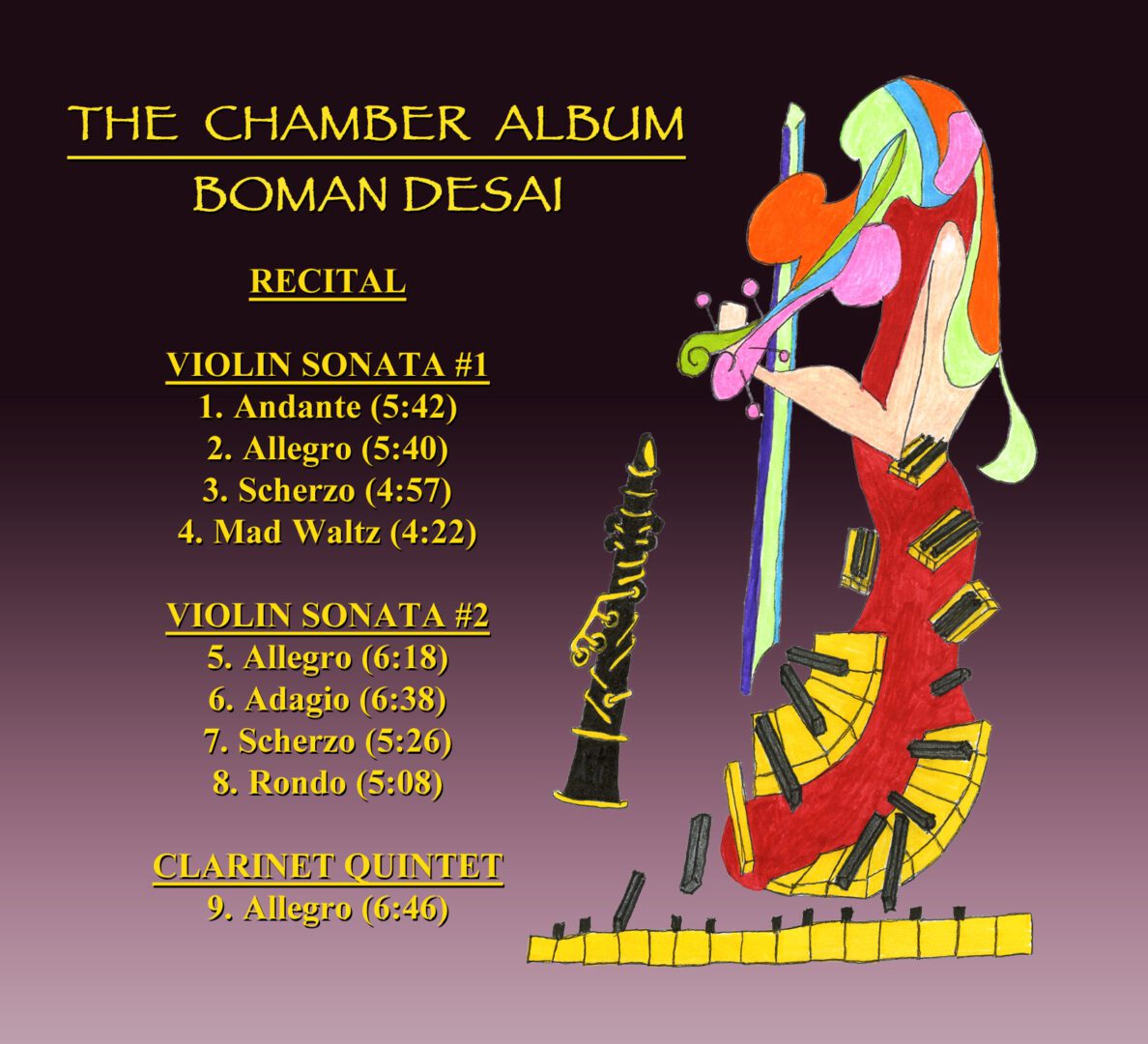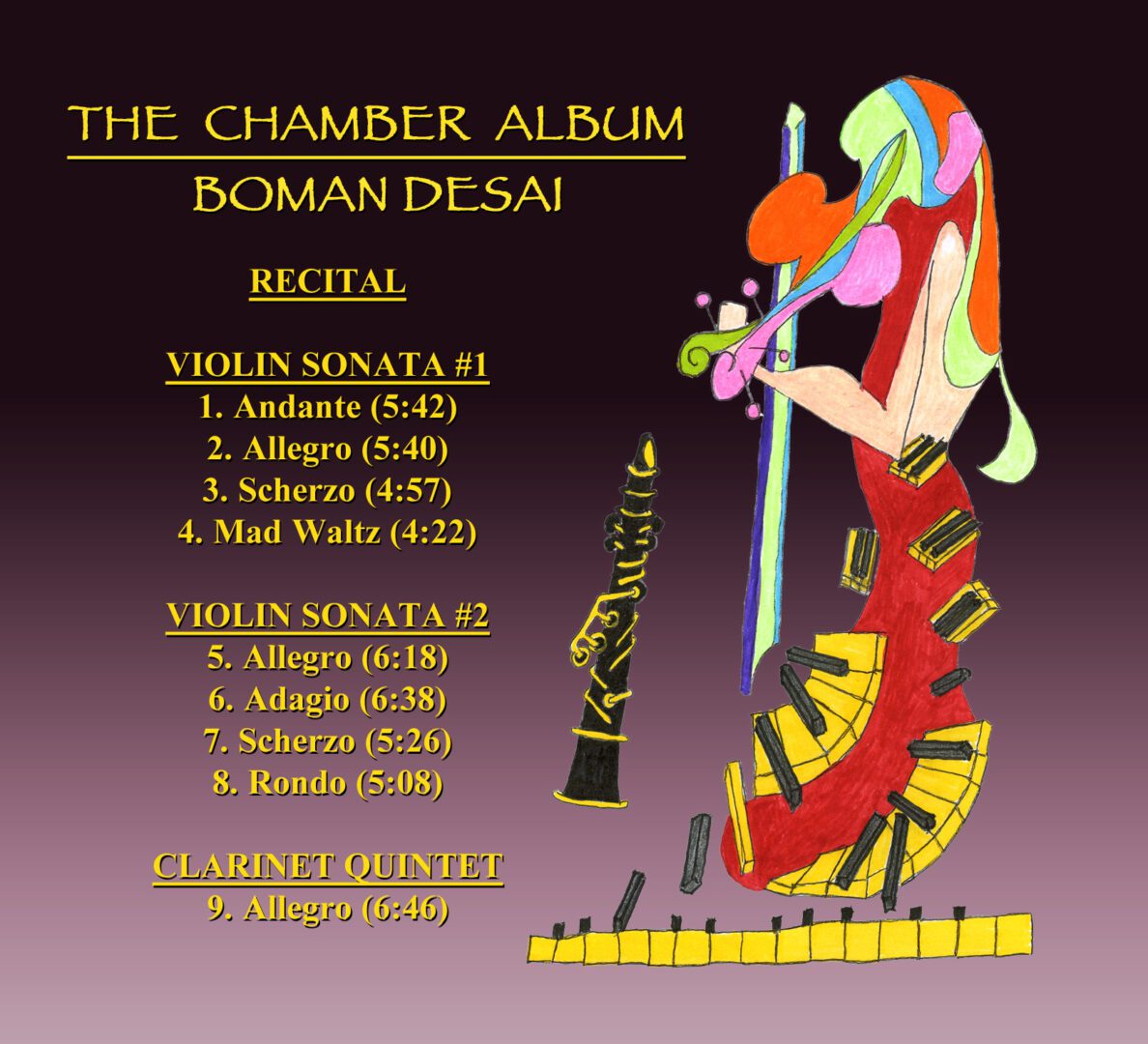THE CHAMBER ALBUM
Please click on any of the three images to hear different snippets from the Sonata and Quintet.
I have been writing songs since my teenage years and understood how chords, melody, and rhythm worked together, but without a formal education I couldn’t write serious music until Finale entered my orbit (software allowing me to compose on a computer) and I realized I finally had an outlet for the music in my head. Better yet, a friend, Shiv Mathur, with a degree in music from Vienna and mastery over Finale, kindly offered to help. Without him, I would have been skating on thin ice. Instead, I peppered him with questions from Chicago via email and received answers from Mumbai within 24 hours.
Hitting a snag with my first violin sonata, I emailed for a solution. Not hearing from him in 3 days, I emailed again to ask if something was wrong. Something was very wrong. He had awakened one morning, paralyzed from the waist down. He’d ignored a pain in his shoulder for more than a year. Someone had told him it was piano-shoulder, all pianists had it—but it was a tumor, metastasized, giving him a month to live: July 2016.
I felt all the helplessness of wanting to do everything, being able to do nothing, asking finally if I might dedicate the sonata to him. He was kind enough to say he would be honored, it was my best work of all he had heard. I worked days and nights, not knowing how much time we had, emailing my progress every 3-4 days. He once wrote to say there was no need to work so hard—adding, “wry grin, but I suppose there is.” I got a complete draft to him 4 days before he died. I don’t know if he was sentient enough to listen—but I had promised him a live performance and got my chance in February 2018 at Mumbai’s Willingdon Club when I dedicated the evening to him and was delighted to have his siblings and sister-in-law in attendance. It was a poignant evening, an audience of about 40—and, for a bonus, I was approached by a Swiss woman after the recital who said that (1) she had enjoyed the performance, and (2) her husband was a direct descendant of Mendelssohn!
The quintet and sonatas on this album were written during my salad days, but I’ve been told what they lack in professionalism and maturity they make up in charm and sparkle.

VIOLIN SONATA #1
Dedicated to Shiv Mathur
First Movement (Andante): When I was 7, a favorite song was “Serenade” from Mario Lanza’s The Student Prince. Sometimes, humming the tune, I found the melody heading in a different direction after the first 2 measures as if it had developed a mind of its own. I followed the new melody to the end to establish the first theme for this movement, adding another persistent melody (of my own) for the second. I followed the structure of Beethoven’s Spring Sonata (the 2 pieces have the same air), but deficient as I was regarding music theory it’s no surprise I went astray. A music professor explained that the second theme needed to be in the dominant key of the first (it isn’t)—but he found the piece charming and advised me not to change a note. I didn’t, but I heeded his caution for subsequent work.
Second Movement (Allegro): Turning one song into a sonata movement (however accidentally), I realized I could do the same with other songs I had written. Elvis Costello had released an album of love songs to his wife, Diana Krall, North, among the finer love songs I have heard (music and lyrics), inspiring me to want to write a love song, something I hadn’t done in years—but Costello’s technique was beyond my reach. I turned instead to It Had to Be You, the first album from Rod Stewart’s American Songbook, which gave me the line, “It Didn’t Have to Be You (but it was),” from which followed my song, from which followed this movement in ABA format, A’s providing bookends for the bouncing B section written specifically to contrast with the A’s.
I was new to serious music, terrified I didn’t know what I was doing, and relieved once I had fulfilled the barest requirements, making for the shortest movements—but the movements grew longer as my confidence grew stronger for later compositions.
Third Movement (Scherzo): A scherzo is generally in ¾ time (not this one), rambunctious, humorous, and structured ABA, A the scherzo theme, B (called a trio) in a mellower mood to contrast with A.
In 1971, working as a drudge in the front office of a college textbook company, bored enough to imagine scurrilous stories about the people I worked with (mostly spinsterish older women), I wrote them into a poem, “Crazy Mary,” later to become a song, still later to become the A section (scherzo theme) of this movement. For the B section (the trio), I created a brand new tune. The song remains memorable to me for my first use of a diminished chord. I recycled the scherzo theme later as a theme and variations in the last movement of a piano sonata.
Fourth Movement (Mad Waltz): Also in ABA format, this movement is more fantastic than formal and the melodies have been with me since at least the 1990s, not as songs (as was the case with the earlier movements), but as miniatures for the piano, especially the tripping keyboard triplets. Those pieces receive a kind of apotheosis in this movement, the violin adding panache to the original.
VIOLIN SONATA #2
First Movement (Allegro): In September 1969, my first month in the US, 19 years old, attending a fraternity party, I met a singer named Maureen who wore a black neckband. I said I wrote songs, she said she’d like to hear them, we went to my dorm room, I sang, she listened attentively, it was a pleasant evening, we planned to meet the next day—but instead of Maureen I found her brother John who said she didn’t go out with Indians. I said we’d made plans, he repeated himself, getting belligerent. Maureen was nowhere to be seen and I left—to write a song the following week about a woman named Maureen who went away. Almost half a century later (2017), the verse of the song became the theme for this first movement, the bridge for the second. Thank you, Maureen! Thank you, John!
Second Movement (Adagio): This slow movement (ABABA) derives from a song from the late 1970s called “Night Light.” The song calls attention to moonlight pouring through a window, leaving the bedroom shimmering and misty, sharp edges blunted—more importantly, softening the lines on the face of the woman asleep in the songwriter’s arms. The verses provided melody for the A sections, choruses for the B sections, leading to the raison d’êtra of the movement in the final A.
I try to do something different with each song I write. I was intrigued by Jethro Tull’s “Living in the Past” because it was in 5/4 time. I used the same time signature for the verses of “Night Light.” The chord progression was inspired by another Tull song, “From a Dead Beat to an Old Greaser.” A series of apparently never-ending chords carries a poignant melody, lyrics drowned in nostalgia. I used a different series of chords, but I would not have discovered my series had I not fallen in love with the series in the Tull song. The chorus of “Night Light” supplied the B segments. I recycled this song twice: first for the slow movement of a piano concerto, second for an episode in the scherzo of a symphony.
Third Movement (Scherzo): I derived this movement from a song I wrote in the 1970s, “The Inner City Blues.” Implicit in the title is my angst about life in my late 20s. I derived the scherzo melody from the verse of the song, composed a brand new trio, and recycled the scherzo later for a symphony.
Fourth Movement (Rondo): I liked the stop-start rhythm of the scherzo too much to let it be, but the scherzo would have become unbalanced had I continued it much further. I chose instead to open the fourth movement with the same theme, giving it a different dressing—not only to open the movement, but to use it as a recurring theme (as is required of the rondo form).
I also realized that just as I had reused the theme from the third movement for the rondo theme, I could reuse themes from the second and first movements for episodes (also required of the form of a rondo). I developed the themes differently, providing the slow movement theme at a headlong pace and foreshortening the theme from the first movement. The final structure resembles ABACA, A the rondo theme, B the second movement, and C the first. Best of all, the reiterations creep up on the listener, providing an unexpected unity to the sonata as a whole. I don’t think this particular format of repeating themes has been used before, but I’m not familiar enough with the repertoire to state that as a certainty.
CLARINET QUINTET
Dedicated to Mary Payne
I arrived early once for a recital and heard Mary Payne warming up her clarinet for the performance. Her tone was so warm, so velvety, I wanted to write something for the instrument. The theme arrived as I was showering the following weekend at the home of a friend. Unable to write music without a keyboard, I hummed the theme continually to myself through the weekend, afraid I might otherwise lose it. It’s a single theme for a single movement used in different incarnations throughout. It would have been a lesser piece had Mary not suggested, among other things, taking fuller advantage of the lower register of the clarinet. It is also the earliest of my compositions that I don’t mind showing people. The two violin sonatas came immediately after. Thank you, Mary!


